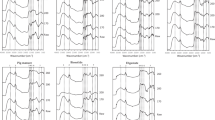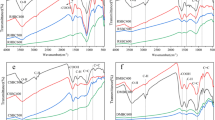Abstract
With the increased interest in the practical use of hydrochar, concerns about the possible environmental biotoxicity of hydrochar and its released dissolved organic matters (DOM) have grown. As a common method for removing bio-oil on the surface of hydrochar, the effect of organic solvent washing on the properties of hydrochar released DOM remains unclear. In this study, we made a comprehensive comparison of hydrochar properties and molecule structure as well as biotoxicity of DOM released from HC (raw hydrochar) and THC (hydrochar washed by tetrahydrofuran). The results indicated that the mass loss of hydrochar was obvious after tetrahydrofuran (THF) washing, and a decline of H/C atomic ratio and increase of N/C and O/C atomic ratios was observed based on Van Krevelen (VK) diagram. This result was further confirmed by FTIR, 13C NMR, and XPS results. Meanwhile, the molecule structure of DOM was shifted to lower molecule weight with higher O-contain compounds after THF extraction due to the demethanation process. However, the biotoxicity experiments indicated that both extracted DOM had no significant impact on germination rate of wheat, and HC-treated sample even exhibited growth superiority. Nevertheless, potential toxicity was observed with the increase of the activity of antioxidant enzymes, and THF washing aggravated the potential oxidative damage through increasing the aromaticity of DOM. Such understanding highlights the importance of evaluating hydrochar and its released DOM before applications, so as to reduce the potential environment biotoxicity.





Similar content being viewed by others
References
Bargmann I, Rillig MC, Kruse A, Greef J, Kucke M (2014) Initial and subsequent effects of hydrochar amendment on germination and nitrogen uptake of spring barley. J Plant Nutr Soil Sci 177:68–74
Baronti S, Alberti G, Camin F, Criscuoli I, Genesio L, Mass R, Vaccari FP, Ziller L, Miglietta F (2017) Hydrochar enhances growth of poplar for bioenergy while marginally contributing to direct soil carbon sequestration. GCB Bioenergy 9:1618–1626
Bento LR, Castro AJR, Moreira AB, Ferreira OP, Bisinoti MC, Melo CA (2019) Release of nutrients and organic carbon in different soil types from hydrochar obtained using sugarcane bagasse and vinasse. Geoderma 334:24–32
Biczak R (2016) Quaternary ammonium salts with tetrafluoroborate anion: Phytotoxicity and oxidative stress in terrestrial plants. J Hazard Mater 304:173–185
Busch D, Kammann C, Grunhage L, Muller C (2012) Simple Biotoxicity Tests for Evaluation of Carbonaceous Soil Additives: Establishment and Reproducibility of Four Test Procedures. J Environ Qual 41:1023–1032
Busch D, Stark A, Kammann C, Glaser B (2013) Genotoxic and phytotoxic risk assessment of fresh and treated hydrochar from hydrothermal carbonization compared to biochar from pyrolysis. Ecotoxicol Environ Saf 97:59–66
Chu QN, Xue LH, Cheng YQ, Liu Y, Feng YF, Yu S, Meng L, Pan G, Hou PF, Duan JJ, Yang LZ (2020) Microalgae-derived hydrochar application on rice paddy soil: higher rice yield but increased gaseous nitrogen loss. Sci Total Environ 717:137127
Fang J, Gao B, Chen JJ, Zimmerman AR (2015) Hydrochars derived from plant biomass under various conditions: characterization and potential applications and impacts. Chem Eng J 267:253–259
Gao P, Zhou YY, Meng F, Zhang YH, Liu ZH, Zhang WQ, Xue G (2016) Preparation and characterization of hydrochar from waste eucalyptus bark by hydrothermal carbonization. Energy 97:238–245
George C, Wagner M, Kucke M, Rillig MC (2012) Divergent consequences of hydrochar in the plant-soil system: arbuscular mycorrhiza, nodulation, plant growth and soil aggregation effects. Appl Soil Ecol 59:68–72
Han LF, Ro KS, Sun K, Sun HR, Wang ZY, Libra JA, Xing BS (2016) New evidence for high sorption capacity of hydrochar for hydrophobic organic pollutants. Environ Sci Technol 50:13274–13282
Hao SL, Zhu XD, Liu YC, Qian F, Fang Z, Shi Q, Zhang SC, Chen JM, Ren ZJ (2018) Production temperature effects on the structure of hydrochar-derived dissolved organic matter and associated toxicity. Environ Sci Technol 52:7486–7495
Hitzl M, Mendez A, Owsianiak M, Renz M (2018) Making hydrochar suitable for agricultural soil: a thermal treatment to remove organic phytotoxic compounds. J Environ Chem Eng 6:7029–7034
Jandl G, Eckhardt K, Bargmann I, Kucke M, Greef J, Knicker H, Leinweber P (2013) Hydrothermal carbonization of biomass residues: mass spectrometric characterization for ecological effects in the soil-plant system. J Environ Qual 42:199–207
Jing XR, Wang YY, Liu WJ, Wang YK, Jiang H (2014) Enhanced adsorption performance of tetracycline in aqueous solutions by methanol-modified biochar. Chem Eng J 248:168–174
Kaushik R, Parshetti GK, Liu Z, Balasubramanian R (2014) Enzyme-assisted hydrothermal treatment of food waste for co-production of hydrochar and bio-oil. Bioresour Technol 168:267–274
Liu P, Xu CM, Shi QA, Pan N, Zhang YH, Zhao SQ, Chung KH (2010) Characterization of sulfide compounds in petroleum: selective oxidation followed by positive-ion electrospray Fourier transform ion cyclotron resonance mass Sspectrometry. Anal Chem 82:6601–6606
Liu FY, Yu RD, Ji XD, Guo MH (2018) Hydrothermal carbonization of holocellulose into hydrochar: structural, chemical characteristics, and combustion behavior. Bioresour Technol 263:508–516
Lu YD, Savage PE (2015) Supercritical water gasification of lipid-extracted hydrochar to recover energy and nutrients. J Supercrit Fluids 99:88–94
Makela M, Benavente V, Fullana A (2016) Hydrothermal carbonization of industrial mixed sludge from a pulp and paper mill. Bioresour Technol 200:444–450
Mansur D, Tago T, Masuda T (2018) Utilization of DDGS using ethanol solution for biocrude oil production by hydrothermal liquefaction. Biofuels 9:325–330
Reddy HK, Muppaneni T, Sun YQ, Li Y, Ponnusamy S, Patil PD, Dailey P, Schaub T, Holguin FO, Dungan B, Cooke P, Lammers P, Voorhies W, Lu XY, Deng SG (2014) Subcritical water extraction of lipids from wet algae for biodiesel production. Fuel 133:73–81
Rillig MC, Wagner M, Salem ML, Antunes PM, George C, Ramke H, Titirici M, Antonietti M (2010) Material derived from hydrothermal carbonization: effects on plant growth and arbuscular mycorrhiza. Appl Soil Ecol 45:238–242
Sun YN, Gao B, Yao Y, Fang J, Zhang M, Zhou YM, Chen H, Yang LY (2014) Effects of feedstock type, production method, and pyrolysis temperature on biochar and hydrochar properties. Chem Eng J 240:574–578
Wang TF, Zhai YB, Zhu Y, Li CT, Zeng GM (2018) A review of the hydrothermal carbonization of biomass waste for hydrochar formation: process conditions, fundamentals, and physicochemical properties. Renew Sustain Energy Rev 90:223–247
Xu ZX, Song H, Li PJ, He ZX, Wang Q, Wang K, Duan PG (2020) Hydrothermal carbonization of sewage sludge: effect of aqueous phase recycling. Chem Eng J 387:123410
Yan WH, Duan PG, Wang F, Xu YP (2016) Composition of the bio-oil from the hydrothermal liquefaction of duckweed and the influence of the extraction solvents. Fuel 185:229–235
Yuan ZW, He C, Shi Q, Xu CM, Li ZS, Wang CZ, Zhao HZ, Ni JR (2017) Molecular insights into the transformation of dissolved organic matter in landfill leachate concentrate during biodegradation and coagulation processes using ESI FT-ICR MS. Environ Sci Technol 51:8110–8118
Zhou BB, Feng YF, Wang YM, Yang LZ, Xue LH, Xing BS (2018) Impact of hydrochar on rice paddy CH4 and N2O emissions: a comparative study with pyrochar. Chemosphere 204:474–482
Zhu XD, Liu YC, Qian F, Zhou C, Zhang SC, Chen JM (2015) Role of hydrochar properties on the porosity of hydrochar-based porous carbon for their sustainable application. ACS Sustain Chem Eng 3:833–840
Zhu XD, Liu YC, Qian F, Lei ZF, Zhang ZY, Zhang SC, Chen JM, Rene ZJ (2017) Demethanation trend of hydrochar induced by organic solvent washing and its influence on hydrochar activation. Environ Sci Technol 51:10756–10764
Zhu XD, Liu YC, Li LJ, Shi Q, Hou JY, Zhang RX, Zhang SC, Chen JM (2019) Nonthermal air plasma dehydration of hydrochar improves its carbon sequestration potential and dissolved organic matter molecular characteristics. Sci Total Environ 659:655–663
Acknowledgments
We thank Xiangdong Zhu for providing hydrochar and technical assistance in DOM structure analysis.
Availability of data and materials
The datasets used and/or analyzed during the current study are available from the corresponding author on reasonable request.
Funding
This work was financially supported by the National Natural Science Foundation of China (41907114, 41807140), China Postdoctoral Science Foundation (2018 M632252), Open Fund of Key Laboratory of Original Agro-Environmental Pollution Prevention and Control, Ministry of Agriculture and Rural Affairs/Tianjin Key Laboratory of Agro-Environment and Agro-Product Safety, Agro-Environment Protection Institution, Ministry of Agriculture and Rural Affairs (18nybcdhj-3), Open Fund of Jiangsu Provincial Key Laboratory of Palygorskite Sciences and Applied Technology (HPK201705), Agricultural Independent Innovation Fund of Jiangsu Province (CX(18)3002) and Research Fund of Jiangsu Academy of Agricultural Sciences (027126111637).
Author information
Authors and Affiliations
Contributions
Guangping Fan performed the experiment, drafted the manuscript; Fei Tong and Weiguo Zhang contributed to the interpretation of the results; Jiangye Li and Lizhu Liu analyzed the data; Yan Gao, Wei Chen, and Gaoling Shi reviewed and edited the manuscript; Zhenhua Zhang and Yan Gao designed the experiment. All authors provided critical feedback and helped shape the research, analysis and manuscript.
Corresponding authors
Ethics declarations
Ethics approval and consent to participate
Not applicable.
Consent for publication
Not applicable.
Competing interests
The authors declare that they have no competing interests.
Additional information
Responsible Editor: Zhihong Xu
Publisher’s note
Springer Nature remains neutral with regard to jurisdictional claims in published maps and institutional affiliations.
Supplementary Information
ESM 1
(DOCX 6546 kb)
Rights and permissions
About this article
Cite this article
Fan, G., Tong, F., Zhang, W. et al. The effect of organic solvent washing on the structure of hydrochar-based dissolved organic matters and its potential environmental toxicity. Environ Sci Pollut Res 28, 26584–26594 (2021). https://doi.org/10.1007/s11356-021-12517-5
Received:
Accepted:
Published:
Issue Date:
DOI: https://doi.org/10.1007/s11356-021-12517-5




